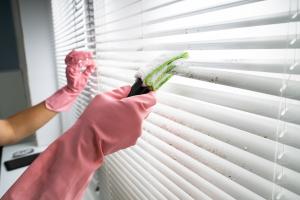Ultimate Guide to Cleaning Venetian Blinds: Step-by-Step Techniques for a Sparkling Shine

-
Quick Links:
- Introduction
- Types of Venetian Blinds
- Essential Tools and Materials
- Step-by-Step Cleaning Guide
- Expert Tips for Maintaining Venetian Blinds
- Real-World Case Studies
- Environmental Considerations
- FAQs
Introduction
Venetian blinds are a popular choice for window treatments, known for their versatility and ability to control light and privacy. However, they also require regular maintenance to keep them looking their best. Dust and grime can accumulate quickly, making them appear dull and dirty. In this comprehensive guide, we will explore effective methods for cleaning Venetian blinds, ensuring they remain in pristine condition.
Types of Venetian Blinds
Before diving into the cleaning methods, it's essential to understand the different types of Venetian blinds:
- Aluminum Venetian Blinds: Lightweight and durable, ideal for high-moisture areas.
- Wooden Venetian Blinds: Offers a warm aesthetic but requires more careful cleaning to avoid damage.
- Faux Wood Blinds: Made from synthetic materials that mimic wood, these are water-resistant and easier to maintain.
- Plastic Venetian Blinds: Lightweight and easy to clean, suitable for kitchens and bathrooms.
Essential Tools and Materials
Gather the following tools and materials before starting the cleaning process:
- Microfiber cloths or dusters
- Vacuum cleaner with a brush attachment
- Bucket
- Warm water
- Dish soap or mild detergent
- White vinegar (optional)
- Rubber gloves (optional)
Step-by-Step Cleaning Guide
1. Dusting the Blinds
Start by dusting your Venetian blinds to remove loose particles. Use a microfiber cloth or a duster to wipe each slat from top to bottom. For aluminum and plastic blinds, a vacuum cleaner with a brush attachment can also be effective.
2. Preparing the Cleaning Solution
In a bucket, mix warm water with a few drops of dish soap or mild detergent. If you prefer a natural solution, you can add a cup of white vinegar to help cut through grime.
3. Cleaning the Blinds
Dip a microfiber cloth in the cleaning solution, wring it out to avoid dripping, and wipe each slat individually. Start from the top and work your way down to prevent dirty water from dripping onto clean areas.
4. Rinsing the Blinds
After cleaning with the solution, use a clean damp cloth to wipe down each slat, removing any soap residue. This step is crucial, especially for wooden blinds, as excess moisture can cause warping.
5. Drying the Blinds
Use a dry microfiber cloth to wipe down the slats again, ensuring they are completely dry to prevent any water damage.
Expert Tips for Maintaining Venetian Blinds
To keep your Venetian blinds looking their best, consider the following expert tips:
- Dust blinds weekly to prevent buildup.
- Use a rubber glove to easily wipe down slats; the rubber will attract dust.
- For stubborn stains, a mixture of baking soda and water can be effective.
- Avoid harsh chemicals that can damage the finish of wooden blinds.
Real-World Case Studies
Let's look at a few real-world examples of effective Venetian blind cleaning:
Case Study 1: Residential Cleaning
A family living in a dusty area found their wooden Venetian blinds were coated in grime. By implementing a bi-weekly cleaning schedule using the step-by-step guide above, they reported a significant reduction in allergens and an improvement in the overall aesthetic of their home.
Case Study 2: Commercial Space Maintenance
A local café struggled with dirty blinds due to grease and food particles. They adopted a monthly deep-cleaning routine, which included professional cleaning services and in-house maintenance, leading to enhanced customer experience and cleanliness.
Environmental Considerations
When cleaning your Venetian blinds, it's important to consider the environment. Opt for eco-friendly cleaning solutions and avoid single-use products. Additionally, maintaining your blinds can extend their lifespan, reducing the need for replacements and minimizing waste.
FAQs
1. How often should I clean my Venetian blinds?
It is recommended to dust Venetian blinds weekly and perform a deep clean every 3-6 months, depending on your environment.
2. Can I use a steam cleaner on Venetian blinds?
Steam cleaning can be effective for some types of blinds, but be cautious with wooden blinds as excessive moisture can warp them.
3. What is the best way to remove stubborn stains?
A paste of baking soda and water can help lift stubborn stains. Apply it gently and rinse thoroughly afterward.
4. How do I clean Venetian blinds without taking them down?
You can clean them while they are still hanging by using a microfiber cloth or duster and a cleaning solution as described in the step-by-step guide.
5. Are there any specific products I should avoid?
Avoid harsh chemicals that can damage the finish of wooden or faux wood blinds, and always test new products on a small area first.
6. Can I wash Venetian blinds in the bathtub?
Yes, if they are removable, you can soak them in a bathtub with warm water and detergent. Make sure to rinse and dry them properly afterwards.
7. How do I keep my blinds dust-free longer?
Regular maintenance, using anti-static dusters, and keeping windows closed during windy days can help keep dust accumulation at bay.
8. Is it safe to use vinegar on wooden blinds?
While vinegar is a natural cleaner, it can potentially damage the finish on wooden blinds. Use it sparingly and always dilute it with water.
9. What’s the best time of year to clean Venetian blinds?
Spring and fall are great times for deep cleaning, as homes tend to accumulate more dust during these seasons.
10. Can I hire someone to clean my Venetian blinds?
Yes, professional cleaning services can offer deep cleaning for your blinds, especially in commercial settings where maintenance is crucial.